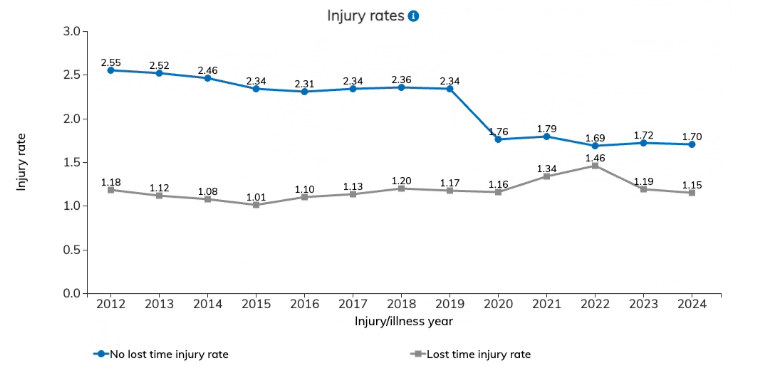WSIB Insights: Rising Injury Costs and the Case for Ergonomic Investment
The Workplace Safety and Insurance Board (WSIB) plays a vital role in supporting Ontario workers and employers through workplace injury claims, prevention programs, and compensation policies. Over the past decade, WSIB has undergone significant changes—especially around the pivotal year of 2020. This post explores how claim trends evolved and highlights the growing financial impact of workplace injuries.
WSIB Claim Trends: Before vs. After 2020
Pre-2020 Stability
Between 2012 and 2019, WSIB injury rates remained relatively stable, averaging around 2.07 injuries per 100 full-time equivalent (FTE) workers. Annual registered claims ranged from 37,000 to over 43,000, with lost-time claims consistently outnumbering no lost-time claims.
2020 Disruption
The onset of the COVID-19 pandemic caused a sharp decline in injury rates, dropping to 1.26 per 100 FTE workers in 2020. This was largely due to lockdowns, remote work, and reduced workplace activity.
Post-2020 Recovery
As workplaces reopened, injury rates began to rise again:
2023: Injury rate reached 2.43 per 100 FTE workers
Healthcare sector: Saw a notable increase in claims, including mental stress and COVID-related injuries
Rising Cost of Injury vs. Ergonomic Investment
WSIB data shows that the average cost of a workplace injury claim has steadily increased, reaching approximately $9,129 per claim in 2024. In contrast, the conservative cost of implementing proactive office ergonomic recommendations is around $2,500.
*information in chart can be found on safetycheck.onlineserices.wsib.on.ca
Trends in Injury Rates and the Impact of Remote Work
Make it stand out
WSIB data shows that no lost-time injury rates dropped significantly in 2020, coinciding with the widespread shift to remote work. Meanwhile, lost-time injury rates remained relatively stable, suggesting that more severe injuries were less affected by the change in work environment.
*information in chart can be found on safetycheck.onlineserices.wsib.on.ca
Implications for Employers
The decline in minor injuries suggests that remote work environments may reduce exposure to physical hazards like slips, repetitive strain injuries, or equipment-related incidents. However, remote work introduces new ergonomic risks, such as poor workstation setup, which can lead to chronic issues if not addressed.
Recommendations for employers:
Invest in ergonomic assessments.
Provide safety & ergonomic training.
Monitor employee well-being and workstation setup.
Why Proactive Ergonomics Matters
Investing in ergonomics can:
Reduce repetitive strain injuries (RSIs) and other workplace injuries
Improve employee comfort and productivity
Lower the frequency and severity of claims
Help maintain or reduce WSIB premiums
Proactive ergonomics is not just a safety measure—it’s a strategic investment in cost control and workforce well-being.
Final Thoughts: Turning WSIB Data into Action
Understanding WSIB claim trends and injury costs is more than a compliance exercise—it’s a strategic opportunity for Ontario employers to reduce risk, control costs, and support employee well-being. As injury rates rebound and claim costs rise, investing in proactive ergonomics and safety solutions can help businesses stay ahead. By aligning workplace practices with WSIB insights, employers can foster safer environments, lower premiums, and build a resilient workforce. For more guidance on ergonomic strategies or injury prevention programs, explore our services page or contact us today.
Keywords: WSIB Ontario, workplace injury trends, injury claim costs, ergonomic investment, remote work safety, lost-time claims, health and safety programs.



